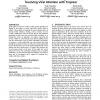Free Online Productivity Tools
i2Speak
i2Symbol
i2OCR
iTex2Img
iWeb2Print
iWeb2Shot
i2Type
iPdf2Split
iPdf2Merge
i2Bopomofo
i2Arabic
i2Style
i2Image
i2PDF
iLatex2Rtf
Sci2ools
GECCO
2007
Springer
2007
Springer
Analysis of noisy time-series signals with GA involving viral infection with tropism
In this paper we report on a study in which genetic algorithms are applied to the analysis of noisy time-series signals, which is related to the problem of analyzing the motion characteristics of moving bodies (distance, bearing, course, velocity, etc.) by covertly sampling the sound of moving objects with submarine monitoring systems that track moving objects travelling on or through the water. In particular, we propose improving the system’s ability to search through noisy data by grafting viruses onto the chromosomes used in genetic algorithms. Specifically, we propose a search method that can cope robustly with noise through the cooperative action of a wide-area search implemented by host chromosomes and a local search implemented by viruses grafted onto these chromosomes. To improve the infection rate, we also impose limits on the types of host entity that can be infected by viruses. By conducting evaluation tests in computer simulations, we show that the proposed technique can...
| Added | 07 Jun 2010 |
| Updated | 07 Jun 2010 |
| Type | Conference |
| Year | 2007 |
| Where | GECCO |
| Authors | Yuji Sato, Yuta Yasuda, Ryuji Goto |
Comments (0)

